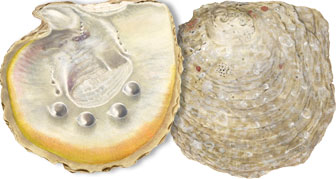
Pearls are formed when a pearl oyster coats any hard particle entering it with layers of nacre, a form of calcium carbonate. Western Australia’s pearling industry focuses on South Sea pearls from the pearl oyster Pinctada maxima. It belongs to the Family Pteriidae, a small family of bivalve molluscs. In WA P. maxima lives in northern coastal waters as far south as Shark Bay. It attaches itself to the sea bottom by tiny threads. It uses its gills to filter tiny food particles of plant and animal matter from the water and can grow up to 300 mm in shell length.
Biology
A pearl oyster is a bivalve (a mollusc that has a shell with two hinged valves).
Diet
Pearl oysters use their gills to filter tiny food particles of plant and animal matter from the water. Growth rates are initially fast and they can reach the minimum legal size for collection (120 mm in shell length) in their third year of life.
Distribution and habitat
In WA P. maxima lives in northern coastal waters. It has been recorded as far south as Shark Bay, but is not commercially fished south of North West Cape. It prefers areas of flat bottom with high water flow; adults can filter as much as one tonne (one cubic metre) of water per day.
Lifecycle
The life cycle of P. maxima is typical of many marine bivalves. It is a protandrous hermaphrodite (meaning it functions first as a male then transforms into a female). It matures first as a male at three to four years of age and at 110-120 mm in length, after which it becomes female. By 170 mm, half are males and half are females. By 190 mm, most are female.
P. maxima can spawn every year so each pearl oyster can function as a male then a female for several spawning seasons.
Primary spawning occurs from mid October to December. A smaller secondary spawning occurs in February and March. Sperm and eggs are spawned into the water, where fertilisation occurs. Egg production by females is extremely high.
The animals develop into a tiny planktonic veliger stage, where the larvae float in the water, allowing them to colonise new areas. Less than one per cent of fertilised eggs survive this stage.
After 28 to 35 days the veliger settles to the bottom. If an appropriate area is found, it settles on it and metamorphoses into the juvenile stage (known as spat) – it starts growing a shell and becomes a sedentary bottom-dweller. If no suitable site is found, it will metamorphose and die.
It is estimated less than five per cent grow successfully to 5 mm.
P. maxima attaches to the sea bottom by tiny threads. It requires a hard surface - and once attached, the connection is permanent. P. maxima can live for up to 40 years.
Predators
In the planktonic stage, predators include pelagic (surface-dwelling) fish, such as mackerel and tuna. In the spat stage, when the shell is soft, predators include demersal (bottom-dwelling) fish, such as snapper. By the adult stage the shell is harder. There are low natural mortalities in this stage, although predators such as turtles and boring worms can prey on adults.
Illustrations © R. Swainston/www.anima.net.au